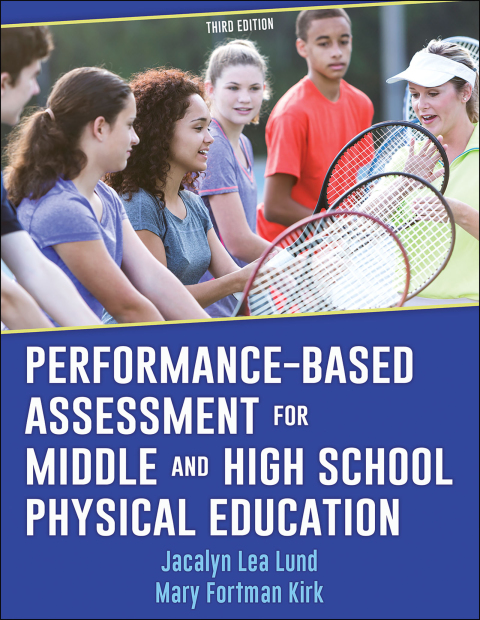Description
Efnisyfirlit
- Cover
- Title Page
- Copyright
- Dedication
- Contents
- Preface
- Acknowledgments
- Part I: Introduction to Performance-Based Assessment
- Chapter 1. The Need for Change
- The Call for Change in Education
- Standards-Based Instruction
- Types of Assessment in Standards-Based Instruction
- Effect on Teaching When Standards Are Used
- Role of Assessment in Physical Education Programs
- Changing the Assessment Culture in Physical Education
- Conclusion
- Chapter 2. Assessing the Psychomotor Domain to Enhance Student Learning
- Purpose of Assessment
- What Are Performance-Based Assessments?
- Characteristics of Performance-Based Assessment
- Types of Performance-Based Assessments
- Advantages of Using Performance-Based Assessments
- Concerns When Using Performance-Based Assessments
- Conclusion
- Chapter 3. Using Cognitive and Affective Learning Domain Assessments Effectively in Physical Education
- Traditional Test Questions Used for Cognitive and Affective-Domain Assessments
- Selected-Response Questions
- Performance-Based Assessments for Cognitive and Affective-Domain Learning
- Projects
- Journals
- Role Plays
- What Are Open-Response Questions?
- Comparing Open-Response and Essay Questions
- Characteristics of Open-Response Questions
- Types of Open-Response Questions
- How to Write Open-Response Questions
- Suggestions for Using Open-Response Questions
- Conclusion
- Chapter 4. Rubrics
- What Is a Rubric?
- Benefits of Using Rubrics
- Criteria for Rubrics
- Choosing the Most Appropriate Rubric
- How to Create Quantitative Rubrics
- How to Create Qualitative Rubrics
- Special Considerations in Creating Rubrics
- Rubric Hints and Guidelines
- Conclusion
- Part II: Managing and Implementing Physical Education Lessons
- Chapter 5. Creating a Classroom Climate That Supports Standards-Based Instruction
- Creating a Positive Learning Environment
- Teacher Expectations
- The Importance of Having a Good Learning Climate
- Structuring the Classroom Environment
- Working With Equipment
- Managing Space
- Managing Time
- Developing Rules for Physical Education Classes
- Reinforcing Behaviors
- Rewarding Positive Behaviors
- Disciplining Students
- Conclusion
- Chapter 6. Effective Teaching Strategies for Standards-Based Instruction
- The Complexity of Games and Physical Activities
- How Much to Include in Your Unit of Instruction
- Application Tasks
- Presenting Learning Tasks
- Monitoring Student Learning
- Asking Questions in Physical Education
- Resources During Instruction
- Pacing and Opportunity to Respond
- Applying Motor Learning Concepts While Teaching
- Conclusion
- Chapter 7. Assessing With Instructional Models
- Direct Instruction
- Sport Education IM
- Tactical Games or Teaching Games for Understanding IM
- Cooperative Learning
- Personalized System for Instruction
- Teaching Personal and Social Responsibility
- Conclusion
- Part III: Components of Performance-Based Assessment
- Chapter 8. Developing Culminating and Progressive Assessments
- Culminating (Summative) Assessments
- Progressive Learning Activities and Assessments
- Tumbling Unit
- Target Archery Unit
- Golf Unit
- Soccer Unit
- Conclusion
- Chapter 9. Planning for Continuous Performance-Based Assessment
- Major Unit Focus
- Culminating (Summative) Assessment and Evaluation Rubric
- Essential Knowledge, Skills, and Abilities
- Progressive Learning Activities and Formative Assessments
- Critical Resources
- Planning Lessons From the Unit Plan
- Conclusion
- Chapter 10. Developing Standards-Based Units of Instruction for Invasion Sports
- Major Soccer Unit Focus
- Culminating (Summative) Assessment and Evaluation Rubric
- Essential Soccer Knowledge, Skills, and Abilities
- Progressive Learning Activities and Formative Assessments
- Critical Resources
- How to Use the Student Soccer Portfolio
- Ultimate: Standards-Based Unit of Instruction
- Major Ultimate Unit Focus
- Culminating or Summative Assessment and the Evaluation Rubric
- Essential Ultimate Knowledge, Skills, and Abilities
- Progressive Learning Activities and Formative Assessments
- Critical Resources
- Conclusion
- Chapter 11. Using Portfolios to Assess Physical Activities and Fitness
- Types of Portfolios
- Advantages of Using Portfolio Assessment
- Disadvantages of Using Portfolios
- Portfolio Guidelines in Performance-Based Assessment
- Evaluating Portfolios
- Integrating Fitness Education and Assessment Into the Physical Education Curriculum
- Resources for Fitness Education Curriculum, Instructions, and Assessment
- Culminating Assessment for a Lifetime Fitness and Physical Activity Unit or Class in High School
- Conclusion
- Chapter 12. Using Standards-Based Instruction to Teach Dance
- Why Include Dance in Physical Education?
- Planning a Dance Unit
- Teaching Structured Dance
- Teaching Creative Dance
- Teaching Social Dance
- Using Portfolios to Assess Dance
- Conclusion
- Part IV: Grading and Implementing Continuous Performance-Based Assessment
- Chapter 13. Effective Grading in Physical Education
- Purposes of Grading and Grade Reporting
- Developing a Meaningful Grading System
- Problems With Traditional Grading Practices
- Grade Formats in Physical Education
- Effective Grading in Physical Education
- Grading Before You Have a Rubric Developed
- Challenges in Using Effective Grading Practices
- Grading Practices for Students With Special Needs
- Hints and Suggestions for More Effective Grading Practices
- Conclusion
- Chapter 14. Acquiring Assessment Savvy
- Planning the Assessment Process
- Lund and Kirk’s Tips for Acquiring Assessment Savvy
- Conclusion
- Glossary
- Bibliography
- Index
- About the Authors






Reviews
There are no reviews yet.